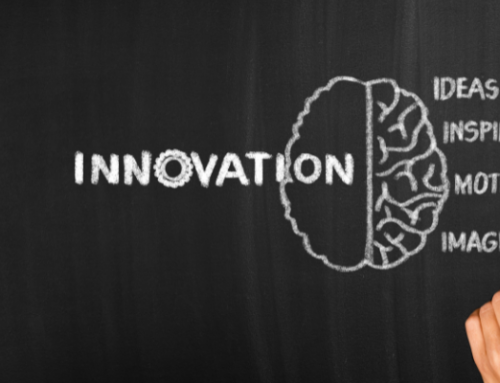
This article was originally published by MonitorDaily in June 2022.
Reprinted with permission from the author.
In an exclusive interview, Tirza Hollenhorst shares how she takes her knowledge for growth and innovation on the industry side and uses that to also focus on the human side of innovation. Her focus on creating and maintaining a well rounded, high functioning team helps her lay the groundwork for team members to build an innovative culture at LUMAN.
The very skills and behaviors continuous innovation requires are not commonly taught in professional development circles. Building a bridge to shape our future necessitates developing “soft” skills that enable high performance – and that can be messy.
Tirza Hollenhorst is the founder and CEO of LUMAN, where she brings her experience in strategy, culture design and innovation together to transform organizations and prepare them for the future of work. I sat down with her to gain practical insights on the human side of innovation. The following is our interview which has been edited for clarity and conciseness.
DEBORAH REUBEN: Tirza, would you share a bit about your background and the journey that led you to what you’re doing today with Luman?
TIRZA HOLLENHORST: Starting in science, I quickly discovered microbial research science wasn’t for me. Eventually, I studied sustainability, large-scale development projects and corporate social responsibility. Organizations began looking at their social and environmental impacts. That leading edge pulled us forward into green business, social enterprise, sustainability, regenerative business and continuous innovation. My career is about how we think about creating the future we want to live in (technology, social and environmental).
Fundamentally, the biggest change we’ll see in creating our future is who we are as people and how we innovate. A, key in Silicon Valley’s innovation successes was the personal development movement that was going on at the individual level, but that history is often glossed over by money-making and significant technological innovations. People didn’t appreciate the personal work underneath creating people who could think big beyond what was possible today, declaring that they would make it so and building companies and teams capable of achieving those outsize dreams.
Best-in-class tools were available for individuals to change their mindset and develop communication and leadership skills but not for companies. You might find innovation tools, but we saw nothing dealing with the real necessary shift in mindset and behaviors for individuals to actually lead and build teams capable of performing at the edge of change, so we created a company providing strategic advisory for facing an uncertain future as well as human development individuals and teams need to work in volatile times.
THE INSPIRATION FOR LUMAN
REUBEN: What other problems in the corporate world inspired the creation of Luman?
HOLLENHORST: We saw many teams with great ideas and inspiration lacking tools and skills to work together – to see things through the entire arc from idea to launch. Scientific studies show that the behaviors and principles making up high-performing teams or the dysfunctional reverse have not fundamentally changed. Neuroscience helps us understand how our brain chemistry and psychology support these teams. We need to understand what makes people feel fulfilled and safe enough to challenge. What makes the team high functioning?
We asked why is nobody doing this? Because it’s messy It’s easy to point to design thinking, lean canvases or other innovation tools. A cool hammer to make things. It’s another thing to sit in front of a human being and say, “Your mindset isn’t working.” We need new mindsets. That’s messy work. Humans only have a mindset shift inside the container of a relationship. You can train new behaviors and maybe get new outcomes. Shifting where they are coming from requires being present and caring about the person in front of you.
From Henry Ford’s factories to the hyper-efficiency of the past 30 years, business industrialization engineered human relationships, creativity and caring for each other out of business – necessary elements for high-performing teams capable of stepping into the unknown. People were just cogs following job descriptions. That works in a world of slow change. Today you need people showing up daily with a different mindset, “I can create, see things, build new things.”
“BIG I” AND “LITTLE i” INNOVATION
REUBEN: Would you share your concept of “big l’ and ‘Witle l’ types of innovation?
HOLLENHORST: We often think of ‘big I’ innovation, whole new technologies, paradigms and business models. The iPhone and Uber are examples of ‘big I’ innovation. But ‘little i’ innovations are micro-changes required to function at the edge of change. It’s small changes in business process, tools, adoption, markets, messaging and even how we think about customer relationships. This organizational capability for continuous “small” innovations means giving people new authority and autonomy. We’re not suggesting handing the keys to the intern, but people hierarchies – everything approved at the top – is not fast enough. We need a hierarchy of purpose enabling empowered people throughout the organization to align with what we’re doing and deliver “small” innovations across the board.
REUBEN: Let’s double click on hierarchy of purpose.
HOLLENHORST: Past ‘people hierarchy’ organizational models provided significant economic and technological development over the years. Executive [teams] filter down to department heads filtering on to everyone delivering in their roles against job descriptions. To stay at the edge, continually delivering against challenges we collectively face, we now need to organize ourselves on a hierarchy of purpose, clarifying the organizational purpose and filtering it down for teams and individuals to identify their role within the larger vision.
Shifting individuals from fulfilling job descriptions to fulfilling a purpose filtering up. Salesforce does this. [Salesforce CEO Marc] Benioff visibly sets the vision, everyone in the organization identifies, shares and commits to their role in it, resulting in everyone understanding each other’s priorities within a shared, larger purpose.
Organizations become aware and aligned on purpose across departments. When people pull together in the same direction, we see distributed decision-making, agency and engagement. People are wiling to challenge old ways of doing things because they no longer fulfill the purpose. We want to create that space and capacity for every individual to innovate from wherever they are, at appropriate risk levels.
FOCUS ON THE HUMAN SIDE
REUBEN: Why is it important to focus on the human side of innovation in times of rapid change?
HOLLENHORST: The critical question is, “Do you want to innovate or be innovative?” You can do it repeatedly if you have the people, process, mindsets and capacities to deliver innovation. If not, you get resistance. The idea people don’t like change is not a complete picture. Individuals want psychological security in their place on a team. Without belonging and assured safety while learning and building something new, security is threatened. We push against the change. It doesn’t feel safe. We may not even know why.
We have psychological safety when making room for everyone to feel safe in their role, learn together and know their unique contributions are welcome. Suddenly, people are pulling for change rather than digging in their heels. You can ignore the human side, but it’s not a long shot to see your initiatives fail.
REDEFINING AND REVEALING CORPORATE CULTURE
REUBEN: Corporate culture goes beyond the water cooler or breakroom. How are you redefining and building corporate cultures?
HOLLENHORST: We broadly define culture as to how we do things; a baseline is how we show up for meetings. For example, is the expectation that we are on time, hydrated, curious about others’ ideas and ready to contribute efficiently so everyone has a voice?
That’s expected of my team. On the other hand, many groups expect [a] delayed start until the highest-paid persons’ late arrival, overloaded agendas, unclear decisions and fuzziness about actions and agreements.
If that’s who we are in meetings (late, hierarchical, unclear and disrespectful of others’ time and value), it carries over into everything. I’m all for team-building experiences that foster real connection when we’ve been so distanced. But that’s not culture. Culture is how we do things. Behavior permeates everything and reveals our culture. We root people in different ways of being. Developing new mindsets, unlocking behaviors and routines to build new ways of collaborating – from simply how we show up for meetings to complex processes taking ideas from signal to launch.
MINDSETS
REUBEN: Where should leaders focus to develop innovation mindset and behaviors?
HOLLENHORST: Focus in shifting mindset in the three early stages of the innovation process. First, there’s a signal. Something is telling us we need to change. Next, we stand in possibility. What could we create, and what is our hypothesis? Then we move on to feasibility. What are we going to do? How is it feasible?
Organizations tend to over-index on taking in ideas but have no place for them to go. They have a mindset of curiosity but aren’t purposeful. They’re not looking for what’s relevant now. Some organizations are great at the next step, standing in possibility, asking what could be. But they don’t move on to considering feasibility. While others go straight to feasibility, knocking down an idea and saying it’s not possible before really thinking it through.
If you do this, you’re never going to be creating next-generation technology because to create technology that never existed, you have to believe something’s possible that’s not actually feasible today. To build a bridge to a future that doesn’t exist yet, we have to separate these stages of standing in possibility (what could be) and feasibility (how we’re going to get there). Unfortunately, most organizations break down in those first three steps.
SHAPING YOUR TOMORROW
REUBEN: What is one thing leaders can do today to shape their tomorrow?
HOLLENHORST: Get clarity: What’s important to you? What do you care about that energizes and lights you up? When do you feel brilliant contributing your best? What outcomes are you moving toward? Answer that for yourself and team [and] your capacity to collaborate and build tomorrow increases exponentially.
One thing you can do tomorrow is ask the person in front of you these same questions and listen. I’ve got decks and classes and courses and 1,001 micro tools, but if you boil it down to one thing, find out what you care about and ask the person in front of you what they care about, and from there, we can build together.
CONCLUSION
Innovation is never only about technology. Culture matters. It’s not on your website. It’s not a teambuilding event. It’s revealed daily in team behaviors. Building culture and mindsets for innovation can be messy. But it’s not impossible. You can develop teams capable of taking on the unknown and delivering breakthrough results. The key: Don’t lose sight of the human side. •
Tirza Hollenhorst is CEO of LUMAN, a human innovation training and development firm catalyzing leaders with capacities needed to create solutions at seed and scale. Trained as a biologist and engineer, she brings tools of ontological design, culture development, business model design and organizational change to align culture and strategy with a thriving future. Learn more at luman.io/monitor.
Deborah Reuben, CLFP is CEO and founder of TomorrowZone, a technology strategy consulting firm bringing forward-thinking insights and original ideas to help companies gain efficiencies and design roadmaps for the future. She holds many industry leadership positions and authored The Certified Lease & Finance Professionals’ Handbook six through eighth editions. Learn more at tomorrowzone.io.





